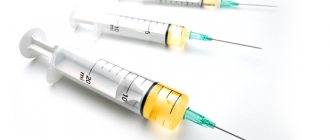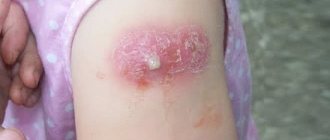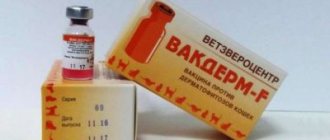Normal reaction to vaccination
It is important for parents to know which reactions are normal and which indicate complications.
About a month after the newborn is vaccinated, reactionary changes develop that are associated with the development of an immune response to the administration of the drug. For this, it is also worth clarifying how long the child’s symptoms persist and how the lump heals.
The vaccine reaction occurs due to the fact that inflammation begins at the injection site, which is accompanied by swelling of the skin and infiltration of the area with leukocyte cells. Externally, this can manifest itself as various symptoms that are characteristic of a vaccine reaction.
Parents should be able to distinguish normal signs of vaccination, which will go away on their own, from complications that require medical intervention. To do this, you need to know what the norm should look like and how long it lasts.
Physiological response to BCG
- Redness and swelling of the skin around the injection site. Skin hyperemia is considered a normal sign of a reaction to the vaccine; it can persist for a very long time - up to 1 year. The appearance of redness depends on the activity of the baby’s immune system. In some babies, the BCG becomes inflamed and turns red within a week; in others, the lump appears in the second or third month of life. This reaction does not require urgent medical intervention, but it is worth informing the pediatrician about this during a routine examination of the baby.
- An abscess or small pustule after administration of the drug. Some newborns develop a small abscess in response to the vaccine, with a white “head” in the center; the skin may become slightly purulent and swollen. The fact that BCG is festering causes panic in many parents, but there is no need to worry, such a reaction can also occur in healthy children. Suppuration is not associated with a violation of the injection technique or non-compliance with the rules of care for the vaccine.
- No skin symptoms. Quite often, parents turn to doctors about the fact that the child’s BCG does not fester and there are no skin changes within a year after vaccination for tuberculosis. There may be several reasons for this. If the drug was administered incorrectly, to too great a depth, then the compaction on the surface of the skin will not be noticeable. The lack of reaction may also be due to the fact that the child has not developed immunity to the bacterium due to his individual characteristics. This is quite dangerous for the baby, since as a result he is still susceptible to Mycobacterium tuberculosis. Therefore, if there is no reaction, it is necessary to undergo additional examination.
- Mild fever. A slight increase in the infant's body temperature is a normal response to the vaccine. Normally, it should not rise above 38 degrees. The fever usually goes away within 2-3 days. If it persists for a longer period, then you should suspect a pathological reaction and consult a doctor.
Healing standards
The listed consequences do not pose a threat to the baby’s health. If BCG has become festered, swollen or red, then there is no need to panic. Over time, they pass, leaving only a small scar on the child’s skin. The size of the scar should not exceed 10 mm. The duration of skin restoration depends on the individual characteristics of the child. On average, the vaccination site heals by 4 months of life; in some children, signs of healing of the BCG scar appear later.
In the first year of life, the baby should undergo regular medical examinations, including regarding the reaction to BCG. This will allow you to detect possible complications from BCG vaccination in time and take measures to eliminate them.
BCG vaccination turned red after a week
One of the mandatory vaccines is the BCG vaccination for children, which is given for the first time immediately in infancy - in the maternity hospital, 3-4 days after the birth of the baby.
There are many myths, various gossip and stories about terrible consequences and complications about it. Having heard them enough, many parents take responsibility and refuse this vaccination without thoroughly understanding it.
Although their first duty is to find out in detail from doctors what BCG is and evaluate the pros and cons of this vaccination.
What it is
BCG is a foreign abbreviation that stands for BCG - Bacillus Calmette, i.e. Calmette-Guerin bacillus. Despite its obligatory nature and relevance in the modern world, not everyone has an idea of what BCG is and what this vaccination is for.
This is a vaccine against tuberculosis, it is prepared from a strain of live but weakened cow tuberculosis bacillus. It is not dangerous to humans, as it is specially grown in an artificial environment. Its main features:
- goal - prevention of tuberculosis;
- protects not from infection, but from the spillover of a latent infection into an open disease;
- prevents the development of severe forms of the disease - tuberculous meningitis, infection of joints and bones, dangerous forms of infection of the lungs;
- makes it possible to achieve a significant reduction in the incidence rate among children.
Since the importance of such vaccination is taken into account, BCG vaccination in newborns is given as early as possible: in the absence of contraindications, even in the maternity hospital. Then, if necessary, it is carried out twice more - this process is called revaccination. The more information parents know about why, where and when children are vaccinated with BCG, the calmer they will be.
Vaccination
One of the most exciting questions about vaccination is how many times children are vaccinated with BCG. According to the generally accepted calendar, three times:
- 3–7 days immediately after the baby is born;
- at 7 years old;
- at 14.
Sometimes in the maternity hospital, for some reason, vaccination against tuberculosis is not carried out (for example, the baby has some contraindications).
If at 2 months the doctor still suggests getting a vaccination, there won’t be any special problems. But after this period (for example, 3 months), before that you will have to do a Mantoux test.
And if only the result is negative, it will be possible to vaccinate. They do the same at 7 and 14 years old.
This technique makes it possible to strengthen the immunity of a small organism to tuberculosis and increase the percentage of resistance to the effects of mycobacteria. Moreover, revaccination at 7 and 14 years of age is mandatory if the child comes into contact with a patient with tuberculosis (for example, someone among relatives is infected).
The second question that worries parents is where newborns are vaccinated with BCG and whether it is dangerous. The usual injection site is the outer side of the left shoulder, the border between the upper and middle 1/3 of the shoulder is selected.
The vaccine is administered intradermally: subcutaneous and intramuscular injections are excluded.
If there are any reasons that prevent the vaccine from being administered specifically in the shoulder, another place is chosen where there is thick skin into which the injection can be easily placed - most often this is the thigh.
Despite the fact that all the information about BCG vaccination for newborns is open and available to parents today, there are still many refusals. Why?
Pros and cons
A very relevant question today is what is more in the BCG vaccination: benefit or harm to the baby’s health? The advantages include:
- minimum consequences;
- complications are very rare;
- no hassle when caring for the injection site: parents often ask whether it is possible to get the BCG vaccine wet - yes, but not to scratch it or smear it with anything;
- reduces the risk of infection with tubercle bacilli;
- when infected, allows the disease to proceed in a milder form;
- prevents death from tuberculosis.
Why is vaccination done?
One of the most important procedures that is done to a child as soon as he is born is the BCG vaccination. This injection is used for rapid immunization against a very severe and deadly disease, namely tuberculosis.
Tuberculosis is a highly contagious disease that affects organs such as the lungs, intestines, bones, and skin. Therefore, the first sign of infection is a prolonged cough, about a month, which is accompanied by sputum production. This cough cannot be treated with conventional methods. In the final stages, the disease is accompanied by hemoptysis, general exhaustion and damage to many organs.
Tuberculosis is most severe in newborns and children under one year of age. The percentage of infected children among all registered patients ranges from 7 to 8%.
Tuberculosis is especially dangerous for the youngest children, because in this case the disease very often also affects the brain, as well as other vital organs. Infection of an infant can occur through airborne droplets from any adult patient when he sneezes, coughs or talks in the presence of a child. The main danger is that many carriers of tuberculosis do not even realize that they have the disease, since they do not feel any symptoms. Few people become infected, only 5-15%.
The BCG vaccination procedure, or tuberculosis vaccination (BCG), is the main way to reduce the risk of contracting this dangerous disease.
The anti-tuberculosis vaccine contains microorganisms that cause tuberculosis, but it is impossible to get infected from them, and their use as a vaccination helps the human body develop strong immunity to the disease.
Normal condition after vaccination
BCG stands for bacillus Calmette-Guerin - this is the name of the tuberculosis bacillus that is part of the drug. The causative agent of the disease is quickly transmitted by airborne droplets, so anyone can become infected. The tuberculosis bacillus is in an inactive state in many people, but when factors are favorable for it, it begins to multiply. Most often, mild complications suffer from this, but severe complications without timely treatment lead to disruption of the functioning of other organs, and in particularly difficult cases, to death.
The development of the pathology is influenced by a weakened immune system, poor lifestyle, and constant stress—the only preventive measure is vaccination.
Vaccination cannot protect a person from mycobacteria, but it reduces serious complications of the disease. Children under two years of age have not developed a protective reaction of the body against infection, so the vaccine will help reduce the severity of the pathology. It will prevent the development of meningitis and other severe forms of pathological abnormalities that end in death.
BCG vaccination is carried out in the first week after birth, repeated revaccination is given to children seven years old.
Then the injection site may fester, although sometimes in children the wound does not fester, but a bubble with liquid forms; when it bursts, a scar is formed. If the BCG vaccination begins to fester and pus flows out of the wound, there is no need to panic, this is a normal reaction to the vaccination.
Such inflammation can be observed for up to four months; the wound is prohibited:- apply ointment or cream;
- peck with a plaster;
- perform any manipulations;
- press, it is better to wipe the discharge with a napkin.
After healing, a scar with a diameter of no more than 8 mm is formed at the injection site. If there is no scar, this indicates the ineffectiveness of BCG vaccination. The child has not developed immunity to the tuberculosis pathogen, so a second vaccination is required.
Vaccination against tuberculosis, even if the scar begins to fester, is often painless, there are usually no serious consequences after BCG, and the baby tolerates it easily. But sometimes the body’s reaction is atypical, which makes parents worry. The most common consequences of BCG vaccination:
- The wound is red - the situation should not cause concern; redness is observed during suppuration and healing of the scar.
- The vaccine has rotted. This is a normal process if the skin around the purulent formation remains clean, without redness or swelling.
If a child experiences extensive swelling around the injection site, it is necessary to contact a pediatrician; the wound may become infected.
- The graft is inflamed, but the tissue around it is in a normal state, so there is no need to panic. If the inflammatory process spreads to the entire shoulder, a doctor's consultation is necessary.
- Rarely, after the injection, a slight body temperature may be observed, when the abscess begins to become inflamed, the temperature rises to 37.5 degrees. This is normal for babies; for older children, such a deviation is not typical and requires consultation with a pediatrician.
When observing such complications after vaccination, you also need to take into account the general condition of the child.
Contraindications and features of vaccination
In Russia, contraindications to BCG vaccination in newborns are as follows:
- The baby weighs less than 2.5 kg at birth.
- There is an immunodeficiency in the child or mother.
- Doctors diagnosed a generalized BCG infection to one of his closest relatives.
- Intrauterine infections, hemolytic disease, serious skin pathologies, and neurological problems have been recorded.
- Newborns have tumors of any size.
BCG should not be given to premature babies weighing less than 2 kg. For such babies, the maternity hospital provides the BCG-M vaccine, which contains half as much dangerous bacteria.
There are three reasons why BCG vaccination is delayed and can be carried out for the first time at 2, 3, 4 months, after a year and even later:
- The child's mother refused to vaccinate her child, and then changed her mind.
- Presence of temporary contraindications.
- Lack of vaccine in the maternity hospital.
If the child’s weight after discharge is more than 2300 g, and there are no contraindications, then the BCG vaccination can be done in the vaccination office of the clinic to which the newborn is assigned.
It is advisable that the clinic have a specialist specifically in administering this vaccine, in order to avoid the risk of developing a cold abscess due to medical error. It is not permissible to vaccinate in the room where blood tests are taken. If the risk of complications is still present, but doctors recommend vaccinating the newborn, the vaccine is administered in the hospital. On an outpatient basis, children who have not received the primary vaccine in the maternity hospital are vaccinated with BCG-M. This reduces the risk of complications, but this vaccination forms immunity against tuberculosis only for 7 years, while the BCG vaccine lasts for 15-20 years.
If the vaccination is given before 2 months, it is generally accepted that the child is not infected with tuberculosis. At the age of over 2 months, a Mantoux test must be done before vaccination to confirm the absence of the disease.
At 3 months the child should receive the first DTP vaccine, and at 4 months - the second. If the BCG vaccination has not been done by this time, then you should not combine vaccinations under any circumstances; such a load on the immune system will be unbearable. It is not recommended that vaccination occur during the hot summer, as the likelihood of complications increases significantly.
Vaccination calendar
If the primary BCG vaccination is done annually, then the child will first have to undergo a medical examination. Primary BCG vaccination after a year allows you to carefully prepare for the manipulation by first doing allergy tests for the components of the vaccine, then the child’s body will respond adequately to the BCG vaccination.
“Even a completely healthy person can get tuberculosis”
The twenty-fourth of March is World Tuberculosis Day. The chief freelance specialist of the phthisiatrician of the Ministry of Health of the Russian Federation, director of the Research Institute of Phthisiopulmonology of the First Moscow State Medical University named after. I. M. Sechenova, professor Irina Vasilyeva.
Irina Anatolyevna, many believe that tuberculosis is the lot of socially disadvantaged people, and it will never affect them. Who is the average TB patient? Can you make his portrait?
“This is a completely wrong idea; a completely healthy person, even with good immunity, can get tuberculosis if he encounters an infectious patient at an unfavorable moment in his life.” If we talk about a portrait, then most often it is a young man 24-35 years old who leads an active lifestyle, and at the same time, perhaps, overworks. He has the means to eat well, but does not have the time. That is, he sleeps little and eats irregularly, plus stress at work. Of course, there must also be an encounter with an infection, which could have happened at any time, even 10 years ago. But this infection wakes up in the body when a person’s immunity drops. For any reason: illness, overwork, stress.
But, of course, socially disadvantaged people are at risk. Their immunity is weakened by poor living conditions, alcoholism, and drug addiction. The morbidity rate is always higher in places of deprivation of liberty - due to deteriorating conditions, living in a common cell, and overcrowding. Moreover, we are not talking about infection, but rather about the development of a disease that did not manifest itself under normal conditions. Infectious prisoners are not placed in common cells - at the entrance everyone is required to undergo fluorographic examinations, and if tuberculosis is detected, the person is treated in the prison hospital.
What other risk groups are there?
— Not only social and behavioral factors, but also medical factors play a role in the development of tuberculosis. Thus, according to WHO, patients with diabetes mellitus develop tuberculosis 4-5 times more often. The likelihood of getting sick increases in people with chronic diseases of the lungs, gastrointestinal tract, as well as in patients who receive medications that suppress the immune system. Such drugs are used in the treatment of cancer, rheumatological diseases, and after transplantation.
The high-risk group includes patients with HIV infection who do not have immune protection. When meeting a patient with a contagious form of tuberculosis, an HIV-infected person picks up Koch's bacillus, and this very quickly develops into a disease, which would not happen in a person with good solid immunity. If infection with tuberculosis occurs earlier than infection with HIV, then the tuberculosis bacterium wakes up, provoking the disease. According to statistics, the likelihood of developing tuberculosis with HIV infection increases 30-40 times. And although in recent years, the total number of tuberculosis patients in Russia has been decreasing, the proportion of such patients with HIV infection is growing.
How does one encounter an infection in general? Is it possible to become infected with tuberculosis in transport and other public places?
- This can happen anywhere - in transport, in supermarkets. It is not even necessary to meet an infectious patient directly; it is enough to simply inhale the air in which droplets of his sputum remain. This often happens in closed spaces with a lot of people. But this does not mean that a healthy person with a normal immune system who catches the infection will definitely get sick. In 9 cases out of 10, immunity is triggered, but people whose body is weakened in some way fall into the remaining 10%. You can become infected with tuberculosis at any age, and most often it occurs in youth. But the infection can lie dormant in the human body while it is calm and stable and protected by the immune system, and wakes up when a malfunction occurs.
All kinds of social upheavals also contribute to the development of the disease - this affects the emotional background, and as a result, the body’s defenses.
Is this what happened in our country after the collapse of the Soviet Union?
— In the 90s, the unstable situation in the country, instability, and migration processes seriously influenced the growth of morbidity. The increase in tuberculosis, associated with socio-economic upheavals in our country, was noted in the late 90s - early 2000s. The fact is that tuberculosis is a disease that develops slowly and slowly recedes. According to statistics, the peak incidence occurred in 2002, and the peak mortality rate in 2005. That is, the development of the tuberculosis epidemic lasted 10 years, and now there is a gradual decline, but the echoes of that period are still felt.
The increase in incidence after the collapse of the Union was also associated with the loss of control over tuberculosis. Our anti-tuberculosis service was destabilized and destroyed, and problems arose with its financing. Tuberculosis is an infection that must be strictly controlled, otherwise the incidence rate will immediately increase.
Has this control now been restored?
- Yes. And thanks to this, morbidity and mortality rates are decreasing in Russia, this has become especially pronounced in the last 3-4 years. We currently have preliminary data for 2021: the incidence rate was 53.3 cases per 100 thousand population, and the mortality rate was 7.8 per 100 thousand. That is, over the past year, mortality has decreased by 15%, and morbidity by 7.7%. This is a very good dynamic; in history there have never been examples of mortality rates decreasing at such a high rate.
But Russia still remains on the World Health Organization’s list of countries with a high burden of tuberculosis - this is due to the absolute number of patients in our country. We have not yet reached the level of European countries, but WHO drew attention to the significant changes that have occurred in our country, and even proposes to make Russia’s experience in the fight against tuberculosis an example for other countries. This year, in Moscow, on the initiative of the Ministry of Health of the Russian Federation, supported by the World Health Organization and personally by WHO Director General Margaret Chan, the first global ministerial conference on tuberculosis in world history will be held, consisting of ministerial delegations of 194 WHO member countries and 40 countries with high burden of tuberculosis, and Russia will act as a leader in the global movement to eliminate tuberculosis.
What kind of experience will Russia be able to share and with whom?
— First of all, Russia can share with countries with a high burden of tuberculosis its system of dispensary surveillance and early active detection of the disease. And now WHO recommends that other countries, following our example, actively search for patients. This practice does not exist in any country in the world; there is only passive detection. That is, when a patient, concerned about some symptoms, goes to the doctor, and during the examination he is diagnosed with tuberculosis. The Russian TB service conducts screening examinations of the healthy population to detect tuberculosis. And this is the most reliable prevention of tuberculosis.
In adults, this is a fluorographic examination, which makes it possible to identify the disease at an early stage, when it has not had time to cause significant damage to the body, and is also not yet contagious, and the person does not pose a danger to others. In children, screening is carried out using skin tests, which reveal the fact of infection. This is necessary in order to catch the moment when the child has already come into contact with Mycobacterium tuberculosis, and take the necessary preventive measures, as well as select children for in-depth diagnostics to identify the developed disease in its initial stage.
In recent years, new algorithms for the diagnosis and treatment of tuberculosis have been developed and implemented in Russia, with an emphasis on a personalized approach to the most problematic drug-resistant forms of tuberculosis, which is not included in the clinical recommendations of other countries. Russia is also famous for its actively developing phthisiatric science and innovation; domestic diagnostic developments have been introduced into practice and are being successfully used, which have attracted the interest of foreign colleagues.
In addition, WHO drew attention to the entire Russian system of control and dispensary observation. A person is seen by a TB doctor not only while he is sick, but also for some time after recovery, and undergoes preventive courses of treatment. And, of course, vaccination. Many Western countries have already abandoned vaccination, and this is justified because their incidence is low. But in countries with high incidence, vaccination is very important - the BCG vaccination does not completely protect against tuberculosis, but it prevents the development of its severe, fatal forms in children.
Why are such vaccinations not given to adults?
— Because adults, mostly, already have a latent tuberculosis infection, that is, they are infected with Mycobacterium tuberculosis. And in these cases it is no longer possible to get vaccinated. Previously, we had a three-stage vaccination: at birth, at 7 years, at 14 and at 21 years. First, the last revaccination was canceled, because by the age of 20-21 all people were already infected, and there was no one left to vaccinate. Now revaccination at 14 years of age has also been cancelled. But for an adult, there is little point in vaccination, since there is no vaccine that would completely protect against tuberculosis.
Read about the symptoms of tuberculosis, its diagnosis, treatment and prevention in the second part of the interview with Professor Vasilyeva.
Irina Reznik
Link to publication: https://medportal.ru/mednovosti/news/2017/03/20/394tb/
What to do if a bump and redness appears after vaccination: treatment
Meanwhile, parents mostly disagree with this harsh stance. They believe that health workers are obliged to warn about possible post-vaccination reactions and especially about the possible complications of certain vaccinations.
However, this is quite troublesome, and in general this issue is extremely difficult - discussions for and against vaccinations for children are very tough today! And doctors prefer not to touch upon this topic again: their job is to vaccinate the child whom you voluntarily brought to the clinic. And any reaction of the child’s body can then be described as “normal.” For the most severe cases, there is another protocol explanation - the individual reaction of the body, which cannot be predicted.
In general, in order not to look for those to blame later, it is better to monitor the quality of the vaccine offered at the site in advance and buy a higher-quality analogue yourself if the need arises. In addition, the child must be prepared for the procedure: a few days before and after vaccination, all potentially negative effects, both physiological and psycho-emotional, must be minimized. It is very undesirable for a vaccinated child to get sick, because his immune system is now weakened. Do not forget also that there are a number of contraindications to vaccination: each time you should make sure that the child does not have any of them.
If the baby has a local or general reaction to vaccination once, then from now on 3 days before the administration of the drug and for 3 days after that it is necessary to give him an antihistamine, which is selected individually by a specialist.
This is about prevention. How to treat redness and thickening after vaccination in a child?
Ideally, contact your pediatrician. He will assess the severity of the reaction and give his recommendations. Doctors often warn mothers that nothing can be done to treat such inflammations! Iodine mesh, compresses, ointments - all this can only worsen the child’s condition. In other cases, nurses recommend the same iodine net, compresses from cabbage leaves or vodka. By the way, about vodka: the method is quite effective, and sometimes even surgeons recommend it when mothers turn to them with similar complaints. You need to soak gauze in the drink and apply compresses to the inflamed area. After 2-3 hours, this application is removed, and after a 2-3 hour break, it is applied again. So throughout the day.
Surgeons also prescribe treating the lump with ointments (Traumel, Troxevasin), Novocaine or Magnesia lotions, Dimexide and Chlorhexidine.
However, even without any treatment, the inflammatory process will gradually decline, pediatricians say. Normally, everything goes away in 2-3 days without any treatment, but sometimes you need to be more patient.
You should consult a doctor only if over time the lump does not decrease in size (and perhaps even increases, exceeding 6-8 cm in diameter) in size or if suppuration begins at the injection site (in this case, you need to go to the hospital immediately! ).
Especially for nashidetki.net - Larisa Nezabudkina
Pathological reaction to BCG
BCG vaccination is dangerous due to a number of serious complications that can occur in a child. The vaccination site may become severely inflamed or fester, and the child’s temperature usually rises to febrile levels (above 38 degrees). Such changes are a reason to consult a doctor to prevent the vaccine from spreading mycobacteria throughout the child’s body.
Many parents do not know what it is - BCG - and what its clinical picture looks like. The symptoms of this disease are as follows:
- Lymphadenitis is inflammation of nearby lymph nodes, accompanied by their enlargement;
- Spread of the abscess over large areas (cold abscess);
- Skin ulcer;
- A colloidal scar is a pathological compaction at the grafting site, covered with swollen red skin.
In rare cases, more severe complications may occur after BCG. These include primarily osteitis and osteomyelitis. These processes occur if the bacteria contained in the vaccine are not restrained by the immune system and enter the child’s bones. This leads to the bone marrow substance becoming rotted.
Another serious complication of vaccination may be a generalized BCG infection. This condition is characterized by the spread of pathogenic microorganisms throughout the infant's body. The occurrence of BCGitis in children requires emergency medical intervention, since its progression can lead to serious consequences.
Common pathological processes during vaccination are currently reduced to a minimum. They occur in very rare cases when contraindications to vaccination were ignored. Therefore, there is no need to be afraid of vaccination and refuse it, as this will provide the child with immunity to tuberculosis.
Why can BCG become inflamed immediately or after some time?
If the BCG vaccine makes your child very red, this is a consequence of one or more factors:
- non-compliance with the rules of drug administration;
- exceeding the vaccine limit;
- use of poor quality composition;
- individual perception of the body;
- BCG vaccination may turn red if there are contraindications to vaccination.
If the BCG vaccine in a newborn is a little inflamed and red, it’s not a big deal. It is difficult to predict how the baby’s body will react to a particular medication. For one, everything may go unnoticed, for another, inflammation will begin. This is the body's normal response and leaves a scar.
What complications cause concern and how to avoid them?
In rare cases, serious complications are possible after BCG, which cause significant disruption to the baby’s health and require adequate treatment. Severe consequences are diagnosed in children with congenital immunodeficiency.
Incorrect technique for performing the procedure also has a negative impact on the child. There are a number of complications after vaccination:
- a cold abscess is observed when the injection is not intradermal, but subcutaneous;
- the formation of an ulcer at the injection site occurs due to increased sensitivity to the active substances of the drug;
- lymph nodes can become inflamed when mycobacteria enter the lymph nodes, the situation requires timely treatment when their size exceeds 1 cm in diameter;
- a keloid scar is caused by a skin reaction to the drug; such a deviation prohibits revaccination at the age of seven;
- generalized BCG infection is a serious complication that develops due to immune abnormalities in an infant.
These consequences are diagnosed extremely rarely, so there is no need to refuse vaccination, it is the only preventive method for preventing tuberculosis. If serious changes in the skin are detected, it is necessary to show the child to a specialist, and an experienced pediatrician will prescribe the correct treatment.
Older children should be re-vaccinated after being examined by a doctor; several vaccinations cannot be given at the same time; the break is one month.
Contraindications
Complications that arise can also be caused by the fact that contraindications were not taken into account during vaccination.
It is prohibited to administer live organisms to newborns if the following signs are observed:
- the child weighs less than two kilograms;
- the baby became infected in the womb;
- the mother was diagnosed with HIV infection;
- immunodeficiency of any nature is observed;
- there are lesions of the central nervous system;
- purulent, inflammatory processes on the skin.
These factors prevent vaccination of young children. Vaccination does not completely protect against tuberculosis; it helps the body develop immunity against pathogenic microbacteria. The effect of the drug lasts about 5–7 years, then you need to give a second injection. Before vaccination, children must undergo a Mantoux test.
For adults and older children, the following contraindications exist:
- positive Mantoux test result;
- severe complications during the first administration of the drug;
- tuberculosis disease or infection;
- oncological diseases;
- pregnancy;
- colds or other chronic diseases during exacerbation;
- allergic reactions.
Recommendations from experts
After vaccination, the child can be bathed in boiled water; before this, the bath can be treated with potassium permanganate or another antiseptic. During water procedures, you should not rub the injection site with a washcloth, steam it, or rub it with a towel.
Until the wound is completely healed, iron the baby's clothes on both sides and put them on carefully so as not to injure this area of skin. During the day it is better not to leave the wound open, cover it with a light blouse
The healing process should occur naturally, without additional manipulation.
It is necessary to protect the child from contact with sick people and not to visit public places. If the baby gets sick during this period, recovery will take a long time. But walks in the fresh air are acceptable if the child looks healthy and feels well.
You must also adhere to the following recommendations:
- Before the procedure, conduct a test for an allergic reaction and compatibility of the active substance with the body;
- after an injection, you should not lubricate the wound with ointments or antiseptics;
- during suppuration, it is forbidden to make an iodine mesh or squeeze out liquid or pus from the wound;
- make sure that the child does not scratch the injection site;
- Before and after the procedure, you cannot change your diet; this will allow you to determine the cause of the allergy.
If any complications occur, you should consult a doctor. The vaccination procedure will not completely protect against the disease, but it will help develop immunity against the causative agent of tuberculosis and prevent the development of serious complications in the event of contracting the disease.
Actions for inflammation
Undesirable consequences occur extremely rarely, so it is still recommended to vaccinate your baby. The vaccine is the only means of preventing tuberculosis. If more serious violations are detected, you need to visit a doctor. A competent pediatrician will prescribe the correct therapy.
Older children are allowed to be vaccinated again only after examination by a doctor. You cannot give several vaccinations in a row. The break must be at least a month.
If the wound begins to fester, parents should under no circumstances touch it. You cannot lubricate it with iodine, anti-inflammatory ointments, or hydrogen peroxide. All means will prevent the body from independently fighting foreign elements and developing full-fledged immunity.
When bathing, it is forbidden to rub the vaccination site with a washcloth or cloth, so that the crust does not fall off and cause pain to the baby. To avoid accidental breakage, you can stick a sterile bandage on the wound.
If BCG is inflamed. Signs and causes
Inflammation at the injection site of the BCG vaccine is completely normal. This is how the body reacts to the administered drug. However, if the inflammation is localized not only in the place where the needle was inserted, but spreads to nearby areas of the skin, then this is already a serious cause for concern.
The most common reactions include:
- Redness of the injection site. Redness in the injection area is normal, so there is no need to worry. However, if the redness spreads to other areas of the skin, then you need to consult a specialist.
- Presence of pus. Often a small abscess filled with pus forms at the injection site. This is normal, but if there is swelling and severe redness around the abscess, then it is quite possible that an infection has gotten inside and the BCG has become inflamed. Parents should carefully examine this place in order to notice these symptoms in time.
- Swelling of the vaccination site. The presence of swelling after the injection should not be a cause for concern. As a rule, the swelling disappears after a few hours. A cause for concern is the presence of edema during the post-vaccination reaction, that is, when suppuration and redness appear. Here you need to consult a phthisiatrician.
- In some cases, an increase in body temperature is observed. Although this is a rare occurrence, it should not cause concern for parents of children under two years of age. If this symptom appears in children under 7 years of age, or in adults, then you need to consult a doctor.
The vaccine may become inflamed approximately 1.5 months after vaccination. Such a delayed reaction is normal, so you need to take this process calmly. The injection site may look like a red pimple or a small abscess. If the surrounding tissues are in normal condition, then there is no reason to see a doctor. If the inflammatory process spreads further, or if the graft begins to become inflamed after a year, then most likely there is a complication after the procedure.
Why can BCG become inflamed immediately or after some time?
There are a number of reasons that cause inflammation after the procedure. It is worth understanding that this is no longer a natural reaction of the body, but a consequence of these factors:
- Vaccination if a child (or an adult) has contraindications to this.
- Failure to comply with vaccine administration technology. The procedure should only be performed by experienced professionals, and this function should not be delegated to trainees or medical professionals with insufficient experience.
- The vaccine may become inflamed due to exceeding the permissible dose of the administered drug. This is also a consequence of the inexperience of medical workers.
- The drug turns out to be of inadequate quality. The reason for this may be the development of osteomyelitis.
- Individual characteristics of the body. Each child (and adult) is individual, so it is difficult to predict the reaction of his body to a particular medical procedure. In some children, the formation and healing of the pustule occurs completely normally, while in some it may become inflamed, etc.
When should BCG not be given to a child or an adult?
Ignoring contraindications can lead to the appearance of an atypical inflammatory process after an injection. To avoid this, a medical professional must know the list of factors that are a contraindication to the administration of the BCG vaccine:
- Underweight newborn baby. According to the rules, its weight must exceed 2.5 kg.
- Presence of chronic diseases. If a child has suffered an intrauterine infection, if he suffers from hemolytic disease, various neurological disorders, then he must first deal with these problems. Vaccination is possible only after the child’s condition has completely stabilized.
- The presence of complications after BCG in the parents and immediate family of the child.
- Maternal immunodeficiency virus.
- Positive Mantoux test.
Only healthy children are vaccinated, therefore the presence of the disease itself, i.e. tuberculosis, is a contraindication to the procedure.
Photo 2: The hospital checks the baby's weight to see if it is normal.
Possible reactions to the BCG vaccine
Many parents consider any body response to a vaccine to be abnormal. This opinion is incorrect, since vaccine reactions are an integral part of the vaccination process.
Normally, after the vaccine is administered, a papule no larger than 1 centimeter in size forms at the injection site. This means that the vaccination was successful and the papule will resolve on its own in half an hour.
Other body reactions may also occur:
- Redness. If the vaccination site turns red and a small abscess has formed in it, do not rush to worry, such a reaction is not considered a pathology. This means that the injection site heals, and the body carries out a natural fight against foreign bodies and develops immunity. Sometimes a dense scar forms at the site of vaccine administration, extending beyond the wound, and the skin turns red and swells slightly.
This reaction is also normal and indicates that the skin has reacted to the vaccine. In addition, the redness of the graft may continue for a whole year. For some this happens within a few days, for some by the end of the month, and for others only after six months. In this case, there is no need to panic and run to consult a doctor, but you need to report redness during a routine examination.
- Swelling. After receiving the vaccine, the injection site may swell slightly. This reaction does not last long - 2-3 days and, as a rule, goes away on its own. In this case, there is no reason to worry. After a month and a half, suppuration begins and a red pimple appears at the site of vaccination, ending with the formation of a scar.
Important! Redness, swelling and suppuration should not spread to the tissue surrounding the graft. If the reaction becomes extensive, you should show the cause of concern to a phthisiatrician, t.
It is possible that the wound may become infected and require treatment.
- Abscess. Often, parents begin to worry if the BCG vaccine turns red and an abscess occurs. In the normal course of the reaction, after a few months an abscess appears at the injection site, which gradually forms a crust. If suppuration of the wound occurs several times, a diagnosis of BCGitis is made, and the doctor prescribes appropriate treatment.
Important! During the healing period, the grafting site is vulnerable to infection. You can’t leave the wound open, much less tear off the scab yourself.
Over time, it will go away on its own, and the grafting site will heal.
- Itching. If the BCG vaccine itches, there is no need to sound the alarm. Itching in this case occurs due to healing and restoration of the skin. However, you cannot rub or comb it; it is best to put a gauze napkin or put on gloves on the child’s vaccination.
- Temperature. If after administration of the vaccine the temperature rises no higher than 38 degrees and lasts for 2-3 days, there is no cause for concern. This is a normal reaction of the body to the introduction of foreign bacteria.
If your child has a high fever for more than 3 days, seek medical help immediately.
- Enlarged lymph nodes. The permissible enlargement of lymph nodes after administration of the vaccine is 1 cm. This reaction indicates the response of the body’s immune system to the vaccine. If the lymph nodes have seriously increased in size, this is a reason to consult a doctor, since this may be a sign of microbacteria entering them, which requires prompt medical intervention to avoid complications.
You should not burn the vaccination site with alcohol-containing substances, smear it with healing creams or seal it before swimming. The healing process of the vaccination site does not require external interventions.
If the injection site is swollen, will there be a scar on the shoulder?
After the pus has completely come out of the wound, it is necessary to cover it with gauze and change the bandage from time to time. Because of the abscess, a scar forms at the site of the vaccination. The process begins with the abscess covering with a scab, after which the inflammation ends and a red pimple appears at the injection site. Over time, its walls become denser, and it itself settles. This process continues until the skin heals.
In some cases, there may be no reaction to BCG even after several months. To determine the cause, it is necessary to perform a Mantoux test.
Lack of response may be due to the following reasons:
- The BCG vaccine was administered incorrectly or its composition was damaged. If the Mantoux test results are negative, revaccination is necessary.
- The scar has formed under the skin and is difficult to see. In this case, you need to consult a doctor who will identify it by the skin tone at the site of vaccine administration.
- If the ruble has disappeared, this indicates that the vaccine has stopped working.
Minor inflammation after the BCG vaccine is considered a normal and natural reaction of the body. There is no need to panic even if pus is detected. However, in some cases, atypical reactions to vaccination are possible, which in the vast majority develop due to improper administration of the vaccine. If severe symptoms or inflammation of other areas of the skin other than the injection site are detected, you should immediately consult a doctor to avoid further complications.
Why does swelling occur at the injection site?
The human immune system is responsible for many small tasks that boil down to a single goal - protection against all diseases. In the first year of life, the child is protected by powerful antibodies received from the mother. Later, breast milk or special formulas strengthen the immune system. Their task is to form a good own immunity to most diseases. Additionally, vaccinations help them.
It is logical that the introduction of even weakened viruses or their specific cells will cause certain reactions. Most of them do not last long and go away within 2-3 days. These include: fever, nausea and diarrhea, a mild form of the disease, for which a vaccine was given, and some local reactions.
If a child's arm or leg is swollen after vaccination, then in most cases this is a normal reaction of the body. There can be no complications with a small tumor. Doctors distinguish 3 types of post-vaccination reactions: complications, moderate and mild.
The last two types are characterized by minor side effects, which are considered normal. Most often, after vaccination, the child’s injection site swells, weakness and drowsiness, and high fever appear.
The tumor is within normal limits
If after vaccination the child’s injection site is swollen, induration and redness appear, this will last on average 1-2 days. In this case, the reaction is considered normal. Statistically, lumps and redness appear in every 4 vaccinated children. Subsequent revaccination can enhance the effect, since during this period the final formation of immunity occurs.
After the DPT vaccination, the child's arm or leg in the area of the injection swells, and the lump can reach 8 cm in diameter. And all this is also considered the norm. If the lump becomes larger than 8 cm, then this indicates non-compliance with the doctor’s requirements, but usually does not pose a danger to the baby. Even a large tumor goes away on its own within a maximum of 5 days. After a BCG vaccination, a swollen lump in a child may become crusty, which is also considered normal.
The only time when a tumor is not considered normal is when additional symptoms occur:
- the appearance of suppuration;
- severe itching, irritability and crying of the child;
- rapidly developing swelling of nearby tissues;
- the appearance of a rash and other unpleasant reactions.
If the temperature rises from 38.5 degrees and persists for 2 days, you should consult a doctor. Such symptoms indicate the presence of an allergic reaction.









